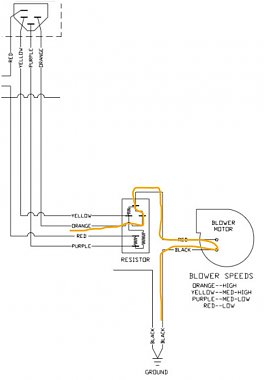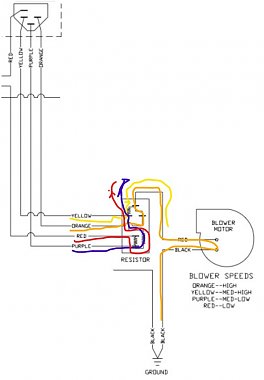Thanks for that diagram , Randy! While it may not be exactly right for the Workhorse, I'm guessing for this small part of the whole, it is close enough and both Workhorse and the others will be close enough to check since it is the resister pack that is most likely involved in the trouble.
This diagram lets us look at why the speed changes and what might be going wrong when all we get is high speed.
The basic idea of this type speed control is that more current flows when resisistance in the path is lower. Add more resistance and current goes down!

As the most simple path, if we look at the high speed current flow, it goes from the switch which puts battery on the orange wire going to the resister pack through NO resisters and on to the motor and finally ground. We get the most current flow and the highest speed!
Then if each switch settings puts that battery on different wires to the resister pack and each path has more resisters in the path, we get progressivly slowers motor speeds.

Simple idea of adding more resistance to the path for each speed. Harder to draw, though, but all the power comes out of the pack to the motor on the red colored wire after taking different routes through the pack.
Sine all these parts havbe been changed and no good result, I would favor going this way to test.
If we put a meter probe on the red wire that connects the path to motor, Pull the power off the switch and then look at the resistance of the different pathes to the motor, we should see each having different resistance!
But that is likely to not be true if the only speed that works is high!
That means, there has to be some reason for the current which is put on the red, purple, and yellow routes can find a way to get to the high speed orange route.
Some things that seem might let it do that are shorts between the wires or connections. Maybe the resister pack has a spot where the connections are against metal when mounted?
Maybe something like the wire bundle runs somewhere it is crushed together?
Maybe the wire bundle got against something hot enough to melt the wires together to cause a short?
Maybe there is a loose part in the switch?
The trick is to use the meter to FIND that short that lets ALL the path use that low resistance high speed path without going through their own slow speed, higher resistance.
Electrons are lazy folks and will go the easy route if they can find it! Your job is to make them go the tough path!